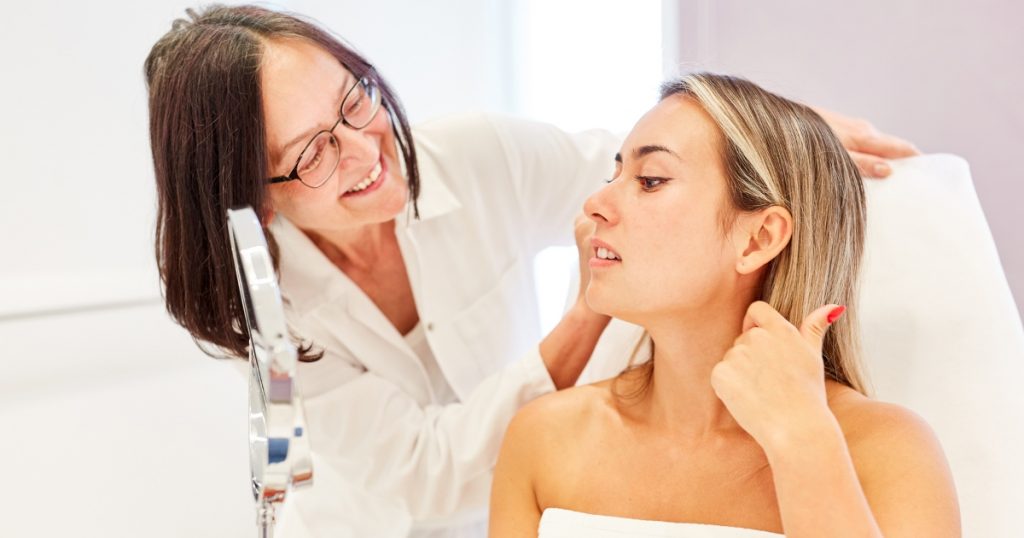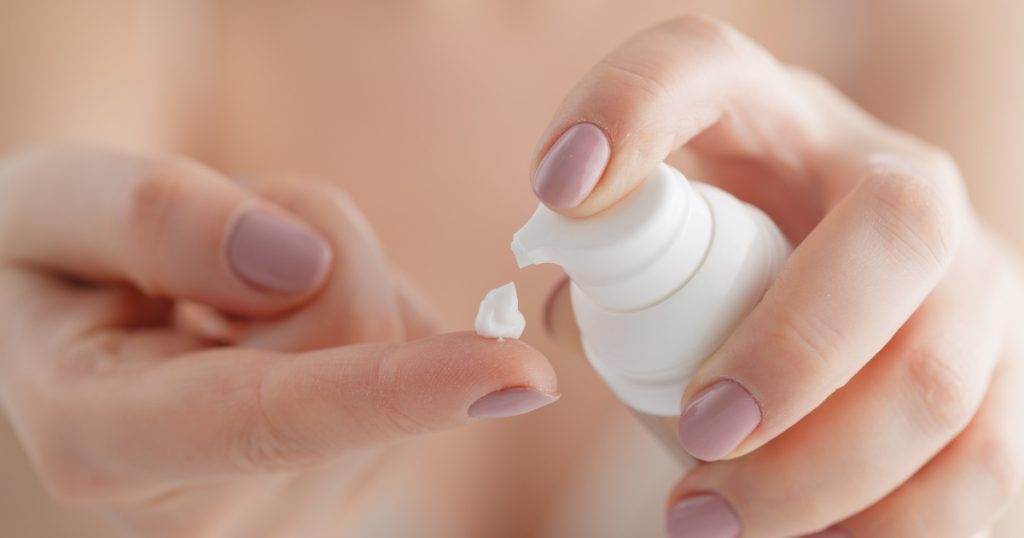The area around the eyes is susceptible, requiring specialised care and treatment for removing Skin tag safely near eye removal. Find out which methods are medically approved, their associated risks, and aftercare procedures to safely remove skin tags near the eyes.
Solutions: Consult a Dermatologist—Removing Skin Tags Safely

Consulting a dermatologist is the safest and most reliable way to remove skin tags near the eyes. Specialists can adequately diagnose and differentiate skin tags from other skin conditions like moles or warts. They also offer sterile, professional environments for effective skin tag removal.
- Expert Diagnosis: Dermatologists can accurately diagnose skin tags and rule out other skin conditions, such as moles or warts.
- Sterile Environment: Medical offices provide a clean, sterile setting to minimise the risk of infection during the removal procedure.
- Multiple Treatment Options: A dermatologist can recommend the most suitable treatment method tailored to your skin type and the specific location of the skin tag.
- Minimal Scarring: Professional removal typically ensures minimal to no scarring, making it preferable.
- Post-Removal Care: A dermatologist can guide you through the essential aftercare steps for quick recovery and minimising complications.
- Insurance Coverage: Some insurance plans may cover the removal cost if deemed medically necessary, thus potentially saving you out-of-pocket expenses.
- Safety: Being under professional care ensures minimal risk of damaging the eye or surrounding skin, making this the safest approach for skin tag removal near sensitive areas like the eyes.
See related: Safe skin tag removal method.
Topical Treatments: Are They Safe for Skin Tags Close to the Eyes?
Topical treatments like creams and ointments are available for skin tag removal, but their safety near the eyes could be better. Ingredients may irritate the eye or cause allergic reactions. Consulting a healthcare professional for targeted treatment in sensitive areas is crucial.
Book A Consultation With Dr Shehzadi Tasneem
Top-rated Plastic Surgeon For Skin Tag Removal in Dubai
Installment Plan Available
- Ingredient Check: Some topical treatments contain strong acids or bases that are unsafe for use around the eyes.
- Prescription Treatments: A dermatologist may prescribe safer, milder topical treatments for sensitive areas.
- Application Risks: There’s a risk of the treatment spreading to the eye, causing irritation or more severe issues.
- Allergic Reactions: Topical treatments may contain ingredients that could cause allergic reactions.
- Effectiveness: These treatments can take longer to show results compared to other methods.
- Cost: Over-the-counter options may be less expensive but come with risks.
- Guidance: You may choose an inappropriate topical treatment for eye-area skin tags without professional advice.
Surgical Methods for Removing Skin Tags Around the Eye Area
Surgically removing skin tags near the eyes often involves snipping or cutting. This method is precise and quick, but it should only be performed by a healthcare professional. Anaesthesia is typically applied to minimise discomfort.
| Factor | Description | Method Used | Aftercare Required |
| Precision | High level of accuracy in removal | Snipping/Cutting | Yes |
| Quick Procedure | Minimal time required for removal | Surgical Removal | Yes |
| Anesthesia | Local anaesthesia to numb the area | Anaesthetic Application | No |
| Sterile Environment | Clean and sterile clinical setting | Clinic/Hospital | No |
| Scarring | The risk of scarring is minimal | Professional Technique | Yes |
| Cost | It can be expensive without insurance | Varies | No |
Cryotherapy: A Quick and Effective Way to Remove Skin Tags Near the Eye

Cryotherapy involves freezing the skin tag with liquid nitrogen, making it one of the quickest and most effective methods. However, extreme caution must be exercised due to the sensitive location near the eyes. Consult a dermatologist for this procedure to ensure safety.
| Factor | Description | Equipment Used | Aftercare Required |
| Speed | Quick procedure time | Liquid Nitrogen | Yes |
| Safety | Low risk when conducted professionally | Cryotherapy Machine | Yes |
| Pain Management | Discomfort is managed via numbing | Local Anaesthesia | No |
| Specialised Equipment | Required for the procedure | Cryotherapy Equipment | No |
| Eye Protection | Measures taken to protect the eyes | Eye Shields | No |
| Aftercare | Specific aftercare requirements | Antiseptic Care | Yes |
The Role of Laser Treatment in Removing Eye-Area Skin Tags
Laser treatment is another option for skin tag removal near the eyes, offering precision and minimal discomfort. However, lasers come with their risks, including eye injury, if protective measures are not followed. Always opt for professional applications for laser treatments near sensitive areas.
- High Precision: Lasers can target the skin tag accurately, minimising damage to surrounding skin.
- Quick Recovery: Laser treatments often have shorter recovery times than surgical ones.
- Eye Protection: Special eye protection minimises the risk of eye damage.
- Cost: Laser treatments can be expensive and are often not covered by insurance.
- Clinical Setting: The procedure should be conducted in a medical setting to ensure safety.
- Multiple Sessions: Some cases may require multiple sessions for complete removal.
- Expertise: Due to the proximity to the eye, specialised training is needed to perform this procedure safely.
Precautions to Take When Dealing with Skin Tags Near Sensitive Areas
Special precautions are necessary when dealing with skin tags near sensitive areas like the eyes. These include proper sterilisation, using anaesthetics, and employing certified professionals. Failure to take these precautions could result in complications.
- Sterilisation: Proper sterilisation techniques reduce the risk of infection.
- Anesthetics: Anesthetics can manage pain but should be administered by a professional.
- Qualified Personnel: Only certified professionals should remove skin tags near the eyes.
- Informed Consent: Ensure you understand all the risks and procedures before undergoing removal.
- Eye Protection: Take additional precautions to shield the eyes during the procedure.
- Post-Procedure Monitoring: Regular follow-ups may be required to monitor healing and detect complications.
- Warning Signs: Be aware of any symptoms of infection or complications and consult a doctor immediately.
See related: Minimize scarring after skin tag removal.
Post-Removal Care: How to Promote Healing and Prevent Infection?
After the removal of a skin tag near the eye, proper aftercare is crucial. This involves keeping the area clean, applying prescribed ointments, and monitoring for signs of infection. Incorrect post-removal care can lead to complications, including delayed healing and infection.
- Antiseptic Care: Use antiseptic solutions to clean the area as directed by your healthcare provider.
- Prescribed Ointments: Apply any prescribed topical medications to aid healing.
- Monitoring: Monitor for signs of infection, such as redness, swelling, or increased pain.
- Follow-up Visits: Schedule follow-up appointments with your dermatologist to monitor healing.
- Avoid Scratching: Do not scratch the area, which can lead to infection.
- Hygiene: Maintain good hygiene to prevent bacterial growth.
- Rest: Limit activities that could stress the affected area to speed healing.
How to Prevent Future Skin Tags from Developing Near the Eye Area?

Preventing future skin tags involves lifestyle changes and skincare routines. Proper hygiene, a healthy diet, and regular check-ups can go a long way in preventing the recurrence of skin tags near the eyes. Consult a dermatologist for personalised advice tailored to your skin type.
- Genetic Factors: Some individuals are more prone to developing skin tags due to their genetic makeup. While you can’t change your genetics, awareness can help you take preventive steps.
- Friction: Skin tags often develop where skin rubs against skin or clothing. Wearing looser clothing and using barrier creams can help reduce friction.
- Obesity: Higher body weight is associated with skin tag development. Weight loss and a balanced diet may prevent their occurrence.
- Hormonal Changes: Pregnancy and certain medical conditions can cause hormonal changes that may contribute to skin tag development. Monitoring and controlling hormone levels may be an effective preventive measure.
- Age: As people grow older, the likelihood of developing skin tags increases. While ageing is inevitable, maintaining good skin hygiene can be preventive.
- Lifestyle Choices: Poor diet and lack of exercise may contribute to skin tags. Adopting a healthier lifestyle can play a role in prevention.
- Diabetes: There’s an increased risk of skin tags for individuals with insulin resistance. Maintaining balanced sugar levels can prevent skin tags from forming.
Successfully Removing Skin Tags Safely near eye options necessitates thorough understanding and consultation with a qualified dermatologist. Professional guidance is crucial to mitigate risks and achieve desired results, whether opting for surgical methods, cryotherapy, or laser treatments. Explore our comprehensive guide for safe and effective skin tag removal near the eyes.
Elevate self-confidence and enhance natural beauty by scheduling a complimentary consultation with Dr. Shehzadi Tasneem Sultan. Distinguished for her fellowships in plastic surgery and extensive expertise in aesthetic procedures, Dr. Sultan specialises in body contouring, facial rejuvenation, and advanced microsurgical techniques.
Her illustrious career includes affiliations with top-tier medical institutions like Great Ormond Street Hospital, London, and Rashid Hospital, Dubai. Secure an opportunity to consult a surgeon at the forefront of innovative plastic surgery methods. Book a Free Consultation now to learn about Keloid Scar Surgery explained by Dr Shehzadi Tasneem.












